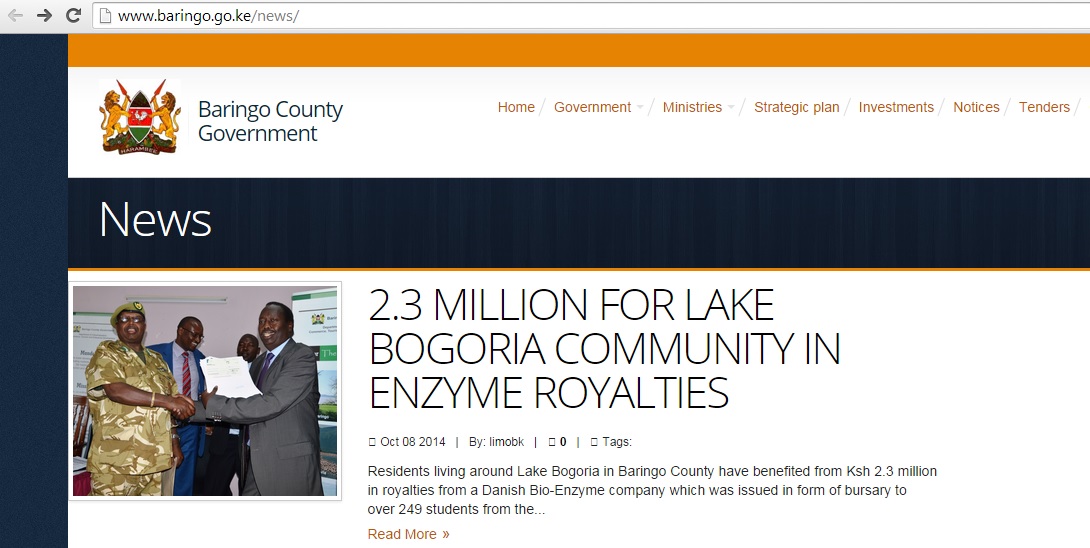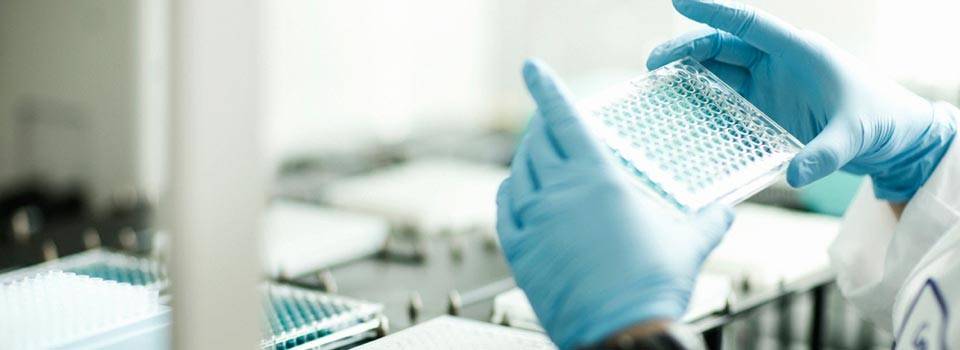Danish Firm Pays 2.3 Million Shillings in Royalties to Endorois Community for Lake Bogoria Enzyme
- Victor Nzomo |
- November 2, 2014 |
- CIPIT Insights

The Baringo County has confirmed recent media reports that residents living around Lake Bogoria in Baringo County have received the sum of KES 2.3 Million in royalties from an unnamed Dutch bio-enzyme company. According to Baringo County news, this royalties deal comes after “successful negotiation between the Kenya Wildlife Service (KWS) and Novo-Enzyme – a foreign company that took an enzyme drawn from a Bacteria in Lake Bogoria hot springs about 15 years ago”. It is reported that the royalties will be partly used as bursaries for over 200 local students while part of the funds will be deployed to fund other development projects in the area. However, local civil society organisations have reportedly demanded full disclosure of all the money from the royalties deal.
This blogpost uses the recent news from Baringo County to examine the protection of genetic resources in Kenya, taking into account Kenya’s new domestic and international rights and obligations in this area.
This case of Lake Bogoria’s enzymes spans over more than 30 years. It begins in the 1980s. Between 1984 and 1986 a Ph.D Botany student wanted to establish what kind of enzymes could be found in lakes of the Great Rift Valley of East Africa, namely: Lakes Bogoria, Magadi, Nakuru, Elementaita and Solai within Kenya, and Lake Natron in Tanzania. These lakes are famous for their salt and soda and their extremely hot geysers. Due to the fact that Kenyan universities do not generally possess the kind of powerful laboratory equipment needed to carry out such a research, this candidate arranged to send samples to major laboratories in the world.
The Ph.D candidate from the University of Leicester reportedly got the endorsement of the National Council for Science and Technology (NCST) to carry out her research with the proviso that she would submit a report of her findings to NCST at the completion of her Ph.D. It was also agreed that the British Council, through Leicester University, would meet fees and accommodation costs while the NCST would sponsor the Kenya part of the research.
The candidate completed her Ph. D. work in 1991 and in 1992 she was awarded a Ph.D in Botany of the University of Leicester. She returned to Kenya thereafter and submitted her report. Her thesis had simply identified, classified and named the organisms present in a particular spot of Lake Bogoria. She submitted her report to NCST in Kenya and continued her teaching job in botany at her university.

As many may know, among the living organisms collected from Kenya’s Lake Bogoria during the research included one responsible an extremophile enzyme, Puradax cellulase that would later be used by Procter & Gamble to develop an extremely successful line of Tide bleach for stonewashing denim clothes.
In August 2004, the East African newspaper published an article titled: “KWS Seeks Millions From Procter & Gamble” in which it is reported that KWS in conjunction with the International Centre of Insect Physiology and Ecology (ICIPE) was claiming a share of the proceeds accruing to the US multinational giant Procter & Gamble and to Genencor International BV of the Netherlands with respect to the sales of Tide Alternative Bleach Detergent and “stonewashing” material. A copy of the article is available here.
In this regard, the point of contention by KWS was that the research permit which was granted to the Ph.D candidate by the Ministry of Education and Technology in Kenya with the recommendation of NCST did not include any commercial involvement of the research findings whatsoever. KWS maintains that if any such additional prospecting was intended, neither the candidate nor the University of Leicester had ever expressed such intention. If they had done so, KWS states that the researchers would have required a new and different kind of permit. Meanwhile the candidate’s story is that she only obtained a permit to carry out the research she had declared in her proposal and that at the end of her doctoral research, she complied with the requirements of her permit by submitting her report.
The relevant parts of the article read:
“We have evidence to indicate that the samples from which the discovery was made were obtained by Dr William E. Grant of the Department of Microbiology and Immunology at the University of Leicester in the UK,” Dr Lwande [head of Bioprospecting and Molecular Biology at Icipe] said.
It is also clear that Dr Grant did not work alone but was in a group of scientists who, though they went ahead to publish their results in the Extremophile Journal of the UK in 1998, did not have any authorisation from KWS.
“We do not have records showing that the scientists had notified KWS nor any indication that they had acquired a research permit from the Ministry of Education before embarking on the sampling,” said Dr Bagine, who added that although the Education Ministry is normally mandated to issue such permits, KWS is empowered to vet proposals made by researchers working in Kenya’s protected areas.
It has also emerged that the group of Leicester University scientists was accompanied by an employee of Genencor, Brian Jones.
“After samples were collected from Lake Bogoria, Brian Jones of Genencor International purchased the samples from Dr Grant and made an enzyme discovery that Genencor later sold to Procter & Gamble,” Dr Lwande said. He added that the particular enzyme was then used as a critical ingredient in the (manufacture) of Tide Alternative Bleach detergent.”
The article also reveals that KWS had officially written to lawyers working for Public Interest Intellectual Property Advisors (PIIPA) in the US to act on their behalf in pursuing Genencor International and Procter & Gamble for royalties from this discovery and (later) from any other possible discoveries associated with (the) Kenyan samples. In a previous blogpost here, we highlighted PIIPA and one of its questionable involvements in Kenyan IP matters.
To date, Genencor International Inc. (USA), a division of Danisco (Denmark) denies any wrongdoing. It denies that it ever sold any such enzymes to its principal business partner, the US multi-billion-dollar giant Procter & Gamble.
Enter Novozyme.
In 1996, Danish firm Novozyme launched the first commercial product based on laccase enzyme: Denilite I, the first industrial laccase and the first bleaching enzyme acting with the help of a redox mediator molecule. In its 2013 report titled “Enzymes at Work”, Novozyme notes:
The textile industry has been quick to adopt new enzymes. So when Novo developed enzymes for stonewashing jeans in 1987, it was only a matter of a few years before almost everybody in the denim finishing industry had heard of them, tried them, and started to use them.
https://www.youtube.com/watch?v=2Oge5qITPJE
From an international intellectual property (IP) perspective, it is important to note that there are three important instruments that Kenya has signed and ratified in the context of protection of genetic resources namely the Convention on Biological Diversity (CBD), the TRIPs Agreement and the Nagoya Protocol on Access to Genetic Resources and the Fair and Equitable Sharing of Benefits Arising from their Utilization to the Convention on Biological Diversity (recently ratified by Kenya in April 2014).
From a national IP perspective, Article 69 of the Constitution is crucial as it imposes certain obligations on the State in respect of the environment. Article 69(1)(a) states that the State shall ensure sustainable exploitation, utilisation, management and conservation of the environment and natural resources, and ensure the equitable sharing of the accruing benefits (In this regard, consider the example of a benefit-sharing deal between a Cape Town firm and the San and Khoi communities, highlighted here from South Africa).
Article 69(1)(c) further states that the State shall protect and enhance intellectual property in, and indigenous knowledge of, biodiversity and the genetic resources of the communities. Finally, Article 69(1)(e) provides that the State shall protect genetic resources and biological diversity.
Interestingly, Article 71 on Agreements relating to natural resources provides that a transaction that involves the grant of a right or concession by or on behalf of any person, including the national government, to another person for the exploitation of any natural resource of Kenya is subject to ratification by Parliament. However this Article of the Constitution will only be operationalised once the relevant Act of Parliament is passed into law.
Against this constitutional backdrop, this blogger reckons that the Ministry for Environment, Water, and Natural Resources would be advised to set up an inter-ministerial committee to address the protection and promotion of genetic resources in Kenya. The work and outcomes from this proposed committee may greatly facilitate co-ordination and co-operation between the national and county governments on the management of in situ genetic resources.

bankelele